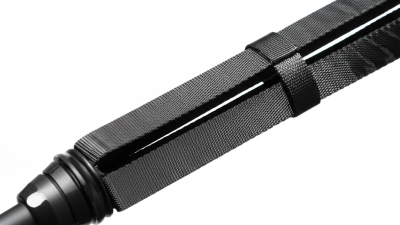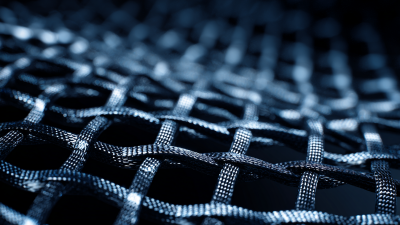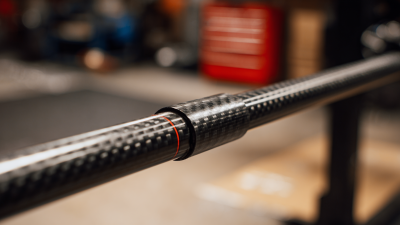
-
Home
-
Products
-
About Us
-
News
-
Blog
-
Video
-
Contact
Leave Your Message

The advent of carbon fiber technology has revolutionized various industries, particularly in the realm of outdoor gear. One of the most compelling innovations is the use of Carbon Fiber Webbing, which offers a perfect blend of strength, durability, and lightweight properties. According to a report by ResearchAndMarkets, the global carbon fiber market was valued at approximately $3 billion in 2020, with a projected CAGR of over 10% through 2026. This surge in demand is driven by the increasing need for advanced materials that enhance performance while reducing bulk. Carbon Fiber Webbing not only provides superior load-bearing capacity but also exhibits excellent resistance to environmental factors, making it an ideal choice for outdoor enthusiasts seeking reliability in their gear. As manufacturers continue to explore the potential of this material, its application in outdoor products is expected to expand, offering consumers enhanced performance and safety in their adventures.

Carbon fiber webbing has emerged as a game-changer in outdoor equipment, offering remarkable properties that enhance performance and durability. Known for its high strength-to-weight ratio, carbon fiber is significantly lighter than traditional materials, making it ideal for gear that needs to be carried over long distances. A report by the Global Carbon Fiber Market indicates that carbon fiber can be up to five times stronger than steel, while being much lighter, which makes it perfect for applications in hiking, climbing, and various outdoor sports.
Moreover, the corrosion resistance and flexibility of carbon fiber webbing provide an added layer of reliability for outdoor enthusiasts. Unlike nylon or polyester, which can degrade over time when exposed to UV light and moisture, carbon fiber retains its integrity, ensuring that gear maintains functionality even after extensive use. Recent research highlights that outdoor products designed with carbon fiber can offer lifetime durability—an essential factor for serious adventurers who depend on their gear in extreme conditions. This unique combination of lightweight design and superior performance positions carbon fiber webbing at the forefront of modern outdoor gear innovation.
| Feature | Carbon Fiber Webbing | Traditional Webbing |
|---|---|---|
| Weight | Lightweight | Heavier |
| Strength | High tensile strength | Moderate strength |
| Durability | Excellent resistance to wear | Less durable |
| Flexibility | Good flexibility | Less flexible |
| Weather Resistance | High resistance to moisture and UV | Prone to degradation |
| Cost | Higher initial investment | Lower cost |
Carbon fiber webbing has emerged as a game-changer in the outdoor gear industry, particularly due to its impressive strength-to-weight ratio. According to a report by Composites World, carbon fiber composites can be up to five times stronger than steel while weighing significantly less. This characteristic makes carbon fiber an ideal choice for camping gear, climbing equipment, and other outdoor products that demand both durability and lightweight functionality. For instance, manufacturers using carbon fiber webbing in tents can reduce overall weight without compromising structural integrity, leading to more efficient packing and easier transport.
When selecting gear with carbon fiber webbing, consider the following tips: First, check the tensile strength specifications provided by the manufacturer to ensure the gear meets your specific needs. Products designed for high-stress environments, such as climbing harnesses, typically feature webbing that can withstand up to 1,500 pounds of force. Additionally, be mindful of the webbing's weave pattern; a tighter weave often translates to better performance in rugged conditions.
Furthermore, the benefits of carbon fiber webbing extend beyond strength and weight. With superior resistance to environmental wear and tear, such as UV light and moisture, it offers long-lasting reliability for outdoor enthusiasts. A study published in the Journal of Composite Materials highlighted that carbon fiber webbing maintains its integrity over time, significantly outperforming traditional materials like nylon or polyester in longevity.
Carbon fiber webbing is revolutionizing the outdoor gear industry, particularly in hiking and climbing equipment. Its high strength-to-weight ratio, often reported to be five times that of steel, allows for lighter, more durable gear. According to a recent market report by Grand View Research, the global carbon fiber market is expected to reach $41 billion by 2026, reflecting the growing adoption in various applications, including outdoor sports. This material not only enhances performance but also contributes to safety, as reducing weight without compromising strength can significantly lower the risk of gear failure in critical situations.
In hiking and climbing gear, carbon fiber webbing is increasingly being used in harnesses, backpacks, and climbing slings. The material's flexibility and resistance to environmental factors, such as UV rays and moisture, make it ideal for outdoor conditions. Studies indicate that gear made with carbon fiber components can last up to three times longer than traditional materials, catering to the needs of avid adventurers who demand reliability and longevity from their equipment. With continuous advancements in manufacturing processes, such as Automated Fiber Placement (AFP), the quality and accessibility of carbon fiber webbing are set to improve, further embedding it as a staple in outdoor gear design.
Carbon fiber webbing has emerged as a groundbreaking material in the realm of outdoor gear, showcasing several advantages over traditional materials like nylon and canvas. One of the most compelling aspects is its lightweight nature, which significantly reduces the overall weight of gear, making it more comfortable for adventurers. Additionally, carbon fiber is known for its superior strength and durability, offering enhanced resistance to wear and tear. This longevity not only translates to better performance but also promises cost savings in the long run, making it a worthwhile investment for frequent outdoor enthusiasts.
**Tip:** When choosing carbon fiber products, look for items that balance strength with flexibility. This ensures that the gear can withstand various conditions while remaining easy to handle.
In a cost-benefit analysis, while the initial investment in carbon fiber webbing may be higher compared to traditional materials, the advantages are clear. The durability of carbon fiber can lead to fewer replacements over time, effectively reducing long-term costs. Furthermore, its resistance to environmental stressors means that users won’t need to spend as much on maintenance and repairs.
**Tip:** Consider the specific activities you'll engage in when selecting gear. For high-intensity or rugged environments, carbon fiber could be the most economical choice due to its high performance in extreme conditions.
The future of carbon fiber webbing technology promises significant advancements that cater specifically to outdoor enthusiasts. According to a report by MarketsandMarkets, the global carbon fiber market is projected to reach $6.83 billion by 2026, reflecting a growing demand for lightweight and high-strength materials in outdoor gear. This trend is driven by an increasing awareness of the benefits of carbon fiber, including its exceptional strength-to-weight ratio and resistance to environmental factors. As manufacturers continue to innovate, we can expect to see more versatile applications of carbon fiber webbing in products such as backpacks, climbing gear, and outdoor clothing.
Emerging technologies such as automated manufacturing processes are set to enhance the production efficiency of carbon fiber webbing. A recent study published in the Journal of Composite Materials highlighted that advancements in resin infusion techniques and 3D weaving allow for even more intricate designs and enhanced performance characteristics. This evolution not only reduces production costs but also enables the development of webbing that can adapt to various outdoor conditions, providing reliable durability while maintaining lightweight properties. As these materials become more mainstream, outdoor enthusiasts will benefit from increased accessibility to high-quality gear that meets their needs for both functionality and performance in diverse environments.





